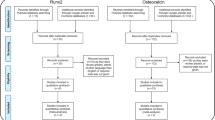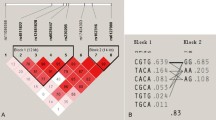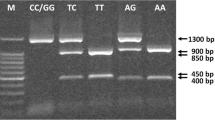Abstract
Summary
One thousand seven hundred seventeen perimenopausal women from the Danish Osteoporosis Prevention Study were genotyped for the −1997G/T, −1663indelT and +1245G/T polymorphisms in the COLIA1 gen. We found that the −1997T allele and a haplotype containing it were associated with reduced bone mineral density (BMD) and increased bone turnover at menopause and after 10 years of follow-up.
Introduction
We wanted to investigate whether the −1997G/T, −1663indelT and +1245G/T polymorphisms in the COLIA1 gene are associated with perimenopausal bone mass, early postmenopausal bone loss and interact with hormone treatment.
Methods
One thousand seven hundred seventeen perimenopausal women from the Danish Osteoporosis Prevention Study were genotyped, and haplotypes were determined. BMD was examined by dual X-ray absorptiometry.
Results
Women carrying the −1997T variant had lower BMD at all measured sites: lumbar spine BMD 1.030 ± 0.137 g/cm2, 1.016 ± 0.147 g/cm2 and 0.988 ± 0.124 g/cm2 in women with the GG, GT and TT genotypes, respectively (p < 0.05) and total hip BMD 0.921 ± 0.116 g/cm2, 0.904 ± 0.123 g/cm2 and 0.887 ± 0.109 g/cm2 in women with the GG, GT and TT genotypes, respectively (p = 0.01). The effect remained after 10 years although statistical significance was lost. Haplotype 3 (−1997T−1663ins+1245G) was associated with lower bone mass and higher levels of bone turnover. Compared with haplotype 1, haplotype 3 carriers had lower BMD at the lumbar spine, femoral neck and total hip by 0.016 ± 0.007 g/cm2, 0.015 ± 0.006 g/cm2 and 0.017 ± 0.006 g/cm2, respectively (p < 0.05–0.005). No association with postmenopausal changes in bone mass and fracture risk and no overall interaction with the effects of hormone therapy could be demonstrated for any of the polymorphisms in COLIA1.
Conclusions
The −1997G/T polymorphism and haplotype 3 are significantly associated with perimenopausal bone mass, and these effects were sustained up to 10 years after menopause. No association between the −1663indelT or +1245G/T polymorphisms and peri- or postmenopausal bone mass could be demonstrated.

Similar content being viewed by others
References
Ralston SH (2005) Genetic determinants of osteoporosis. Curr Opin Rheumatol 17:475–479
Bagger YZ, Tanko LB, Alexandersen P, Hansen HB, Mollgaard A, Ravn P, Qvist P, Kanis JA, Christiansen C (2004) Two to three years of hormone replacement treatment in healthy women have long-term preventive effects on bone mass and osteoporotic fractures: the PERF study. Bone 34:728–735
Ralston SH, Uitterlinden AG, Brandi ML, Balcells S, Langdahl BL, Lips P, Lorenc R, Obermayer-Pietsch B, Scollen S, Bustamante M, Husted LB, Carey AH, Diez-Perez A, Dunning AM, Falchetti A, Karczmarewicz E, Kruk M, van Leeuwen JP, van Meurs JB, Mangion J, McGuigan FE, Mellibovsky L, Del MF, Pols HA, Reeve J, Reid DM, Renner W, Rivadeneira F, van Schoor NM, Sherlock RE, Ioannidis JP (2006) Large-scale evidence for the effect of the COLIA1 Sp1 polymorphism on osteoporosis outcomes: the GENOMOS study. PLoS Med 3:e90
Garcia-Giralt N, Nogues X, Enjuanes A, Puig J, Mellibovsky L, Bay-Jensen A, Carreras R, Balcells S, Diez-Perez A, Grinberg D (2002) Two new single-nucleotide polymorphisms in the COL1A1 upstream regulatory region and their relationship to bone mineral density. J Bone Miner Res 17:384–393
Bustamante M, Nogues X, Enjuanes A, Elosua R, Garcia-Giralt N, Perez-Edo L, Caceres E, Carreras R, Mellibovsky L, Balcells S, Diez-Perez A, Grinberg D (2007) COL1A1, ESR1, VDR and TGFB1 polymorphisms and haplotypes in relation to BMD in Spanish postmenopausal women. Osteoporos Int 18:235–243
Liu PY, Lu Y, Long JR, Xu FH, Shen H, Recker RR, Deng HW (2004) Common variants at the PCOL2 and Sp1 binding sites of the COL1A1 gene and their interactive effect influence bone mineral density in Caucasians. J Med Genet 41:752–757
Stewart TL, Jin H, McGuigan FE, Albagha OM, Garcia-Giralt N, Bassiti A, Grinberg D, Balcells S, Reid DM, Ralston SH (2006) Haplotypes defined by promoter and intron 1 polymorphisms of the COLIA1 gene regulate bone mineral density in women. J Clin Endocrinol Metab 91:3575–3583
Yazdanpanah N, Rivadeneira F, van Meurs JB, Zillikens MC, Arp P, Hofman A, van Duijn CM, Pols HA, Uitterlinden AG (2007) The −1997 G/T and Sp1 polymorphisms in the collagen type I alpha1 (COLIA1) gene in relation to changes in femoral neck bone mineral density and the risk of fracture in the elderly: the Rotterdam study. Calcif Tissue Int 81:18–25
Long JR, Liu PY, Lu Y, Dvornyk V, Xiong DH, Zhao LJ, Deng HW (2005) Tests of linkage and/or association of TGF-beta1 and COL1A1 genes with bone mass. Osteoporos Int 16:86–92
Husted LB, Harslof T, Gonzalez-Bofill N, Schmitz A, Carstens M, Stenkjaer L, Langdahl BL (2009) Haplotypes of promoter and intron 1 polymorphisms in the COLIA1 gene are associated with increased risk of osteoporosis. Calcif Tissue Int 84:85–96
Garcia-Giralt N, Enjuanes A, Bustamante M, Mellibovsky L, Nogues X, Carreras R, Diez-Perez A, Grinberg D, Balcells S (2005) In vitro functional assay of alleles and haplotypes of two COL1A1-promoter SNPs. Bone 36:902–908
Bornstein P (1996) Regulation of expression of the alpha 1 (I) collagen gene: a critical appraisal of the role of the first intron. Matrix Biol 15:3–10
Mann V, Hobson EE, Li B, Stewart TL, Grant SF, Robins SP, Aspden RM, Ralston SH (2001) A COL1A1 Sp1 binding site polymorphism predisposes to osteoporotic fracture by affecting bone density and quality. J Clin Invest 107:899–907
Jin H, van’t Hof RJ, Albagha OM, Ralston SH (2009) Promoter and intron 1 polymorphisms of COL1A1 interact to regulate transcription and susceptibility to osteoporosis. Hum Mol Genet 18:2729–2738
Uitterlinden AG, Burger H, Huang Q, Yue F, McGuigan FE, Grant SF, Hofman A, van Leeuwen JP, Pols HA, Ralston SH (1998) Relation of alleles of the collagen type Ialpha1 gene to bone density and the risk of osteoporotic fractures in postmenopausal women. N Engl J Med 338:1016–1021
Mosekilde L, Hermann AP, Beck-Nielsen H, Charles P, Nielsen SP, Sorensen OH (1999) The Danish Osteoporosis Prevention Study (DOPS): project design and inclusion of 2000 normal perimenopausal women. Maturitas 31:207–219
Abrahamsen B, Gram J, Hansen TB, Beck-Nielsen H (1995) Cross calibration of QDR-2000 and QDR-1000 dual-energy X-ray densitometers for bone mineral and soft-tissue measurements. Bone 16:385–390
Lund B, Sorensen OH (1979) Measurement of 25-hydroxyvitamin D in serum and its relation to sunshine, age and vitamin D intake in the Danish population. Scand J Clin Lab Invest 39:23–30
Charles P, Poser JW, Mosekilde L, Jensen FT (1985) Estimation of bone turnover evaluated by 47Ca-kinetics. Efficiency of serum bone gamma-carboxyglutamic acid-containing protein, serum alkaline phosphatase, and urinary hydroxyproline excretion. J Clin Invest 76:2254–2258
Keiding R, Horder M, Gerhart W, Pitkanen E, Tenhunen R, Stromme J, Theodorsen L, Waldelstrom J, Tryding N, Westlund L (1974) Recommended methods for the determination of four enzymes in the blood. Scand J Clin Lab Invest 33:291–306
Miller SA, Dykes DD, Polesky HF (1988) A simple salting out procedure for extracting DNA from human nucleated cells. Nucleic Acids Res 16:1215
Lau HH, Ng MY, Ho AY, Luk KD, Kung AW (2005) Genetic and environmental determinants of bone mineral density in Chinese women. Bone 36:700–709
Yamada Y, Ando F, Niino N, Shimokata H (2005) Association of a −1997G–>T polymorphism of the collagen Ialpha1 gene with bone mineral density in postmenopausal Japanese women. Hum Biol 77:27–36
Zhang YY, Lei SF, Mo XY, Wang YB, Li MX, Deng HW (2005) The −1997 G/T polymorphism in the COLIA1 upstream regulatory region is associated with hip bone mineral density (BMD) in Chinese nuclear families. Calcif Tissue Int 76:107–112
Braga V, Mottes M, Mirandola S, Lisi V, Malerba G, Sartori L, Bianchi G, Gatti D, Rossini M, Bianchini D, Adami S (2000) Association of CTR and COLIA1 alleles with BMD values in peri- and postmenopausal women. Calcif Tissue Int 67:361–366
Harris SS, Patel MS, Cole DE, Dawson-Hughes B (2000) Associations of the collagen type Ialpha1 Sp1 polymorphism with five-year rates of bone loss in older adults. Calcif Tissue Int 66:268–271
Mann V, Ralston SH (2003) Meta-analysis of COL1A1 Sp1 polymorphism in relation to bone mineral density and osteoporotic fracture. Bone 32:711–717
Langdahl BL, Ralston SH, Grant SF, Eriksen EF (1998) An Sp1 binding site polymorphism in the COLIA1 gene predicts osteoporotic fractures in both men and women. J Bone Miner Res 13:1384–1389
Tran BN, Nguyen ND, Center JR, Eisman JA, Nguyen TV (2009) Enhancement of absolute fracture risk prognosis with genetic marker: the collagen I alpha 1 gene. Calcif Tissue Int 85:379–388
Ji GR, Yao M, Sun CY, Zhang L, Han Z (2009) Association of collagen type I alpha1 (COLIA1) Sp1 polymorphism with osteoporotic fracture in Caucasian post-menopausal women: a meta-analysis. J Int Med Res 37:1725–1732
Berg JP, Lehmann EH, Stakkestad JA, Haug E, Halse J (2000) The Sp1 binding site polymorphism in the collagen type I alpha 1 (COLIA1) gene is not associated with bone mineral density in healthy children, adolescents, and young adults. Eur J Endocrinol 143:261–265
Hustmyer FG, Liu G, Johnston CC, Christian J, Peacock M (1999) Polymorphism at an Sp1 binding site of COL1A1 and bone mineral density in premenopausal female twins and elderly fracture patients. Osteoporos Int 9:346–350
McGuigan FE, Murray L, Gallagher A, vey-Smith G, Neville CE, Van't HR, Boreham C, Ralston SH (2002) Genetic and environmental determinants of peak bone mass in young men and women. J Bone Miner Res 17:1273–1279
Garnero P, Borel O, Grant SF, Ralston SH, Delmas PD (1998) Collagen Ialpha1 Sp1 polymorphism, bone mass, and bone turnover in healthy French premenopausal women: the OFELY study. J Bone Miner Res 13:813–817
Jin H, Stewart TL, Hof RV, Reid DM, Aspden RM, Ralston S (2009) A rare haplotype in the upstream regulatory region of COL1A1 is associated with reduced bone quality and hip fracture. J Bone Miner Res 24:448–454
Albagha OM, Pettersson U, Stewart A, McGuigan FE, MacDonald HM, Reid DM, Ralston SH (2005) Association of oestrogen receptor alpha gene polymorphisms with postmenopausal bone loss, bone mass, and quantitative ultrasound properties of bone. J Med Genet 42:240–246
Salmen T, Heikkinen AM, Mahonen A, Kroger H, Komulainen M, Saarikoski S, Honkanen R, Maenpaa PH (2000) The protective effect of hormone-replacement therapy on fracture risk is modulated by estrogen receptor alpha genotype in early postmenopausal women. J Bone Miner Res 15:2479–2486
Tofteng CL, Kindmark A, Brandstrom H, Abrahamsen B, Petersen S, Stiger F, Stilgren LS, Jensen JE, Vestergaard P, Langdahl BL, Mosekilde L (2004) Polymorphisms in the CYP19 and AR genes–relation to bone mass and longitudinal bone changes in postmenopausal women with or without hormone replacement therapy: the Danish osteoporosis prevention study. Calcif Tissue Int 74:25–34
Deng HW, Li J, Li JL, Johnson M, Gong G, Davis KM, Recker RR (1998) Change of bone mass in postmenopausal Caucasian women with and without hormone replacement therapy is associated with vitamin D receptor and estrogen receptor genotypes. Hum Genet 103:576–585
Gerdes LU, Vestergaard P, Hermann AP, Mosekilde L (2001) Regional and hormone-dependent effects of apolipoprotein E genotype on changes in bone mineral in perimenopausal women. J Bone Miner Res 16:1906–1916
James L, Onambele G, Woledge R, Skelton D, Woods D, Eleftheriou K, Hawe E, Humphries SE, Haddad F, Montgomery H (2004) IL-6-174G/C genotype is associated with the bone mineral density response to oestrogen replacement therapy in post-menopausal women. Eur J Appl Physiol 92:227–230
Heegaard A, Jorgensen HL, Vestergaard AW, Hassager C, Ralston SH (2000) Lack of influence of collagen type Ialpha1 Sp1 binding site polymorphism on the rate of bone loss in a cohort of postmenopausal danish women followed for 18 years. Calcif Tissue Int 66:409–413
Simsek M, Cetin Z, Bilgen T, Taskin O, Luleci G, Keser I (2008) Effects of hormone replacement therapy on bone mineral density in Turkish patients with or without COL1A1 Sp1 binding site polymorphism. J Obstet Gynaecol Res 34:73–77
Brown MA, Haughton MA, Grant SF, Gunnell AS, Henderson NK, Eisman JA (2001) Genetic control of bone density and turnover: role of the collagen 1alpha1, estrogen receptor, and vitamin D receptor genes. J Bone Miner Res 16:758–764
McGuigan FE, Reid DM, Ralston SH (2000) Susceptibility to osteoporotic fracture is determined by allelic variation at the Sp1 site, rather than other polymorphic sites at the COL1A1 locus. Osteoporos Int 11:338–343
Acknowledgements
This study was supported by the European Commission (Grant QLK6-CT-2002-02629 (GENOMOS)). We thank Liselotte Stenkjaer and Mette Carstens for skilful technical assistance and DOPS investigators for collaboration.
Conflicts of interest
None of the authors have any conflict of interest related to this study.
Author information
Authors and Affiliations
Corresponding author
Rights and permissions
About this article
Cite this article
González-Bofill, N., Husted, L.B., Harsløf, T. et al. Effects of COLIA1 polymorphisms and haplotypes on perimenopausal bone mass, postmenopausal bone loss and fracture risk. Osteoporos Int 22, 1145–1156 (2011). https://doi.org/10.1007/s00198-010-1292-4
Received:
Accepted:
Published:
Issue Date:
DOI: https://doi.org/10.1007/s00198-010-1292-4




